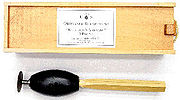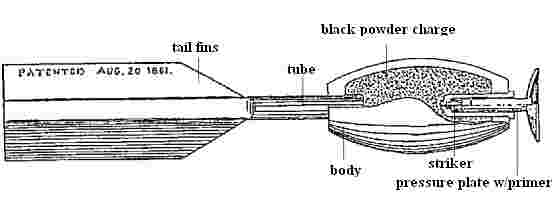
Ketchum Grenade
Encyclopedia

Grenade
A grenade is a small explosive device that is projected a safe distance away by its user. Soldiers called grenadiers specialize in the use of grenades. The term hand grenade refers any grenade designed to be hand thrown. Grenade Launchers are firearms designed to fire explosive projectile grenades...
used in the American Civil War
American Civil War
The American Civil War was a civil war fought in the United States of America. In response to the election of Abraham Lincoln as President of the United States, 11 southern slave states declared their secession from the United States and formed the Confederate States of America ; the other 25...
. It was patent
Patent
A patent is a form of intellectual property. It consists of a set of exclusive rights granted by a sovereign state to an inventor or their assignee for a limited period of time in exchange for the public disclosure of an invention....
ed on August 20, 1861 by William F. Ketchum, and was partially adopted in the Union Army
Union Army
The Union Army was the land force that fought for the Union during the American Civil War. It was also known as the Federal Army, the U.S. Army, the Northern Army and the National Army...
. They were used in such battles such as Vicksburg
Battle of Vicksburg
The Siege of Vicksburg was the final major military action in the Vicksburg Campaign of the American Civil War. In a series of maneuvers, Union Maj. Gen. Ulysses S. Grant and his Army of the Tennessee crossed the Mississippi River and drove the Confederate army of Lt. Gen. John C...
and Petersburg (both major sieges in the war).
Overview
The grenades have the appearance of a cast-iron ball, or a skinny dart, having fins of cardboard to stabilize the flight. They assured landing on the nose, which was backed by a percussion capPercussion cap
The percussion cap, introduced around 1830, was the crucial invention that enabled muzzleloading firearms to fire reliably in any weather.Before this development, firearms used flintlock ignition systems which produced flint-on-steel sparks to ignite a pan of priming powder and thereby fire the...
that set off the main powder charge in the body. The grenades were largely inefficient because they had to land on their nose to detonate. In one incident Confederates caught them in blankets and hurled them back at the attackers.
Ketchums came primarily in 1, 3 and 5 lb. varieties. The most recognized Confederate copy is the Raines Grenade. It was even less effective In most cases, the body was the same, but a long cloth streamer was substituted for the fins, and the plunger was a contact explosive.
Construction

The grenade was a three-piece weapon, consisting of the plunger (or nostril), casing (body or orange shell, containing main charge), and tailpiece. The slightly convex metal plunger was removed to set the percussion cap
Percussion cap
The percussion cap, introduced around 1830, was the crucial invention that enabled muzzleloading firearms to fire reliably in any weather.Before this development, firearms used flintlock ignition systems which produced flint-on-steel sparks to ignite a pan of priming powder and thereby fire the...
on the nipple within the casing; the plunger was refitted through means of depressing by the striking of something hard and solid to drive it back. This proved to be difficult, especially in the fray of battle. The wood tailpiece was removed to place the powder charge inside the shell, and then set firmly back in to hold the powder within. Trajectory had to be an arc in order for the plunger to detonate the piece. A small pressure spring attached to the side of the plunger stem held the plunger in place during flight. The grenade was stabilized by four thin cardboard fins set into a wood tailpiece protruding from the rear of the projectile.
In action
"When William Ketcham demonstrated his new invention of a grenade that could be thrown like a dart, he hit the bulls eye observers were very impressed with its explosive power. However, Union troops who used the Ketchum grenade in great numbers in their attacks at Port Hudson found its limitations. Lt. Howard C. Wright, described the scene from the Confederate side of the assault:
'The enemy had come this time prepared with hand grenades to throw into our works from the outside. When these novel missiles commenced falling among the Arkansas troops they did not know what to make of them, and the first few which they caught not having burst, they threw them back upon the enemy in the ditch. This time many of them exploded and their character was at once revealed to our men. Always equal to any emergency, they quickly devised a scheme . . . Spreading blankets behind the parapet, the grenades fell harmlessly into them, whereupon our boys would pick them up and hurling them with much greater force down the moat they would almost invariably explode.'
Dickey and George, who quote this account in their work Field Artillery Projectiles of the American Civil War (1980, p. 459), also note that although over 100 Ketchum grenades, both 3 and 5-pounders, were recovered at Port Hudson, not one grenade fragment was found."

